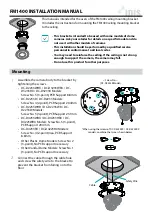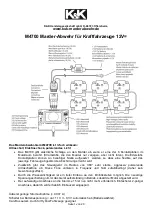
ALM
®
12V7 s-Series User’s Guide
Chapter 5: Operation and System Design Considerations
406014-02EN, Rev. 05
© 2016 NEC Energy Solutions, Inc. All rights reserved.
Page 31 of 49
This document contains the proprietary information of NEC Energy Solutions, Inc. (“NECES”) and may not be modified,
reproduced, retransmitted or redistributed, either in whole or in part, for any reason without NECES’ prior written consent.
High Temperature Operation
Both charge and discharge functions increase battery temperatures. High rate battery usage
causes the largest temperature increase. The ALM 12V7 s-Series battery’s over temperature
protection (OTP) circuitry removes voltage from the terminals if the battery exceeds the
temperature limits. During high rate battery usage, the user must ensure that ambient
operating temperature combined with the charge or discharge rate does not exceed the
operational temperature limits.
shows how the ALM 12V7 s-Series usage rate and
ambient temperature relate to measured delta SOC before entering OTP state.
Under certain conditions, the ALM 12V7 s-Series terminals will exceed the 70°C touch
temperature limit as described in UL 1973. For operation beyond those terminal touch
temperature limits, not to exceed 90 °C, the ALM 12V7 s-Series batteries will require the
placement of guards to prevent accidental contact. NEC Energy Solutions recommends that
additional testing be conducted under specific use cases. The gauge of wire may be changed
depending on final temperature requirements and application.
Table 11 Thermal Capability and Delta SOC, BOL
a
Usage Rate:
Charge or
Discharge
Current (A)
25 °C Ambient
b
b.
Testing was with 10 AWG cables at 25 °C and 60 °C
c
c.
100% = 5 Ah
60 °C Ambient
b c
ALM 12V7s
ALM 12V7s HP
ALM 12V7s
ALM 12V7s HP
% delta SOC
% delta SOC
% delta SOC
Internal Limit
% delta SOC
Internal Limit
5
100
100
100
100
10
100
100
84.4
90.4
23
100
100
17.9 (10.9 TT
d
)
25.6 (7.0 TT
d
)
d.
TT = Touch Temperature. The % delta SOC TT when Touch Temperature (TT) of the terminal exceeds 70 °C. A cover or other
protection is required to prevent incidental contact per UL1973.
30
N/A
e
e.
N/A = Not Applicable. The 12V7s battery is not capable of achieving this charge or discharge current.
100
N/A
e
20 (5.0 TT
d
)
45
N/A
e
100
N/A
e
12 (2.5 TT
d
)
NOTE
Cell life will be limited by exposure to high temperatures.
a.
The values in this table show the battery’s performance prior to engaging its protection circuitry.
















































